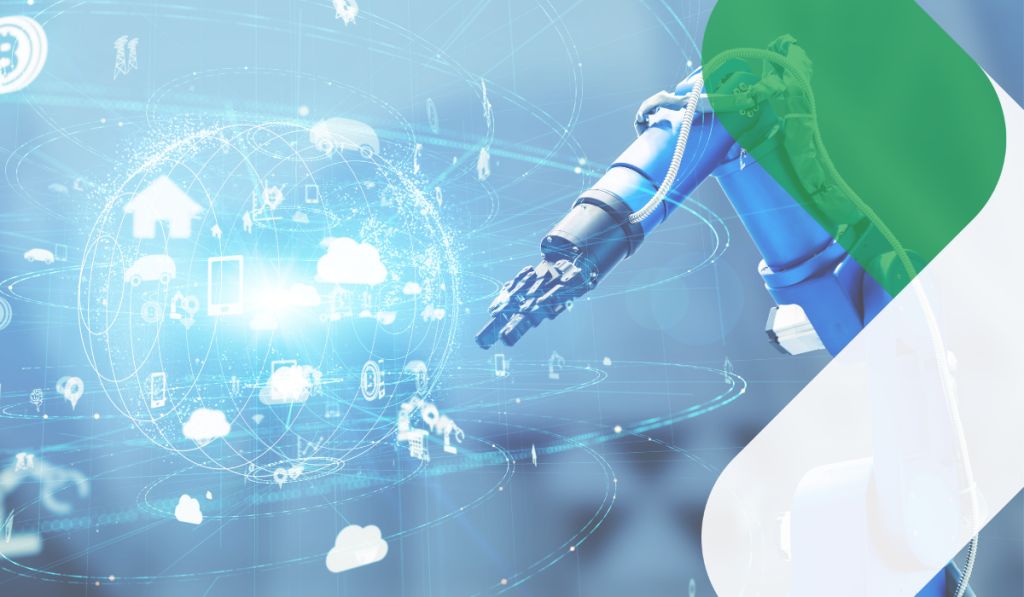
Automation Solutions Aimed at Reducing Energy Consumption and Waste
This article explores how automation can help reduce energy consumption and waste. With the right approach, organizations can make meaningful progress toward sustainable efficiency.
The industrial automation market is forecasted to reach $395.09 billion by 2029 at a compound annual growth rate of 9.8% from 2022. Europe is expected to dominate the market share between now and 2029, and the Asia Pacific region, with megamarkets in China and Japan, is the fastest-growing market.
The automotive, logistics and supply chain, energy and utilities, electronics, heavy manufacturing, and packaging sectors are expected to be the biggest beneficiaries of industrial automation advancements. There’s also tremendous potential for industrial automation in the healthcare industry.
Businesses must weave industrial automation into their operations and strategies. There’s no other way to survive in today’s highly competitive business landscape and volatile global economy.
This article explores the current state of industrial automation, exciting trends, challenges, opportunities, and what the future holds.
Industrial automation involves a combination of software, robotics, control systems, machinery, and other adjacent technologies to perform and complete tasks previously done by human workers.
Companies that provide custom industrial automation services are crucial in enabling this transformation. They understand the unique requirements of different industries and design tailored solutions to automate manufacturing processes effectively.
Industrial automation is enriching a variety of industries and driving growth in speeds and trajectories previously unseen.
Key trends in industrial automation begin with the growth of smart factories and the advancement of Industry 4.0. Smart factories are highly interconnected digital facilities that employ internet-connected machinery to enhance performance, productivity, and safety and increase profit margins. The automation industry is a key component of Industry 4.0 and is one of the defining technological advancements in our lifetime.
The increased use of autonomous robots and cobots (collaborative robots) on factory floors are important elements of industrial automation. Robotic Process Automation (RPA), which is a process that enables humans to train software robots to complete digital tasks autonomously, is a powerful capability of industrial automation.
Industrial automation is triggering the widespread rise of AI and machine learning (ML) in various operational processes. According to Gartner, 79% of corporate strategists view AI and ML as integral to their success between now and 2025. The different use cases of AI-powered analytics, according to the surveyed corporate strategists, include descriptive, diagnostic, multimedia, predictive, network, prescriptive, geospatial analytics, natural language processing (NLP), and digital twins.
Other key industrial automation trends include the increasing adoption of cloud infrastructures and edge computing, which involves the convergence of IT and OT systems that can streamline workflows, increase productivity and operational efficiency, increase innovation potential, and nurture a robust cybersecurity posture.
Last but not least, industrial automation is built upon internet-connected devices. Therefore, there is a proliferation of IoT (internet-of-things) devices in industrial environments, which are engines for innovation, growth, and profit-making.
Industrial automation is driven by various factors influencing its widespread adoption and continuous development. These drivers are shaping the manufacturing landscape and fueling the growth of automation technologies.
Here are some key drivers of industrial automation:
One of the primary drivers of industrial automation is the desire to enhance productivity and operational efficiency. Automation systems can perform tasks faster, more accurately, and more consistently than manual labor. By automating repetitive or labor-intensive processes, manufacturers and enterprises can optimize production cycles, minimize errors, reduce cycle times, and achieve higher output levels. Increased productivity leads to cost savings, improved competitiveness, and better utilization of resources.
Automation technologies can deliver significant cost savings over time. Although there may be an upfront investment in implementing automation systems, the long-term benefits outweigh the initial costs. By streamlining processes, reducing waste, and improving quality control, automation helps minimize production costs. Moreover, automation can result in labor savings by replacing manual labor with machines or robots, reducing the need for human intervention and associated labor expenses. The potential for cost reduction and favorable ROI makes industrial automation attractive for many manufacturers.
Consistency and high-quality outputs are crucial for manufacturing operations. Human workers may experience variations in performance due to fatigue, distractions, or human errors. Automation ensures consistent and standardized processes, resulting in improved product quality. Automation technologies can precisely control variables, monitor quality parameters, and perform inspections at high speeds, leading to better product consistency, reduced defects, and enhanced customer satisfaction.
Industrial automation creates safer work environments. By replacing humans with automated systems in hazardous or physically demanding tasks, the risk of workplace accidents and injuries can be significantly reduced. Automation can handle heavy lifting, repetitive motions, exposure to harmful substances, or work in extreme temperatures or confined spaces. This protects workers and minimizes the financial and legal risks associated with workplace injuries and compensation claims.
The ability to adapt quickly to changing market demands and product variations is a crucial driver for industrial automation. Flexible automation systems can be reprogrammed or reconfigured to accommodate different product specifications, customization requirements, or production volumes. This agility allows manufacturers to respond swiftly to market trends, customer demands, and supply chain dynamics. Automation provides the flexibility needed to adjust production lines, change workflows, and introduce new products or variants with minimal downtime or retooling.
Rapid advancements in technology are driving industrial automation forward. Innovations such as robotics, machine learning, artificial intelligence, the Internet of Things (IoT), and big data analytics are revolutionizing manufacturing processes. These technologies enable intelligent automation, predictive maintenance, autonomous systems, and real-time monitoring and control. The constant evolution and accessibility of advanced technologies provide manufacturers with new opportunities to optimize their operations and gain a competitive edge.
Manufacturers face intense competition and market pressures in today’s globalized economy. To remain competitive, companies must continually improve their efficiency, reduce costs, and deliver products faster while maintaining high quality. Industrial automation allows manufacturers to meet these challenges by enabling leaner operations, faster time-to-market, improved supply chain management, and increased overall competitiveness.
The changing demographics and evolving workforce landscape also contribute to adopting industrial automation. Many industries face skill gaps and labor shortages, making finding and retaining skilled workers for manual tasks challenging. Automation can alleviate the strain on the workforce by handling repetitive or physically demanding jobs, allowing human workers to focus on higher-value activities such as problem-solving, innovation, and complex decision-making.
These drivers of industrial automation are shaping the future of manufacturing. By embracing automation technologies, manufacturers can unlock numerous benefits, ranging from increased productivity and cost savings to improved quality control, workplace safety, and market competitiveness.
Retrofitting existing or legacy software systems in manufacturing is paramount in today’s industrial landscape. Many manufacturing facilities continue to rely on outdated software systems implemented years ago. However, these legacy systems often need more flexibility, scalability, and integration capabilities to keep up with the demands of modern manufacturing. Retrofitting and automating such systems offers several crucial benefits:
Retrofitting existing software systems can significantly enhance operational efficiency and productivity. Outdated systems usually lack automation features, real-time data analytics capabilities, or streamlined workflows. By retrofitting with modern software solutions, manufacturers can automate processes, optimize production schedules, reduce manual intervention, and gain valuable insights from real-time data. This results in increased efficiency, reduced downtime, improved resource allocation, and higher productivity levels.
Retrofitting existing software systems is often more cost-effective than completely replacing them. Replacing legacy systems can be complex and expensive, involving hardware upgrades, data migration, training, and potential disruptions to ongoing operations. Retrofitting allows manufacturers to leverage existing infrastructure while selectively upgrading components or integrating new software modules. It minimizes upfront investment and helps businesses achieve a faster return on investment (ROI) by maximizing the value of their current technology investments.
Legacy software systems often suffer from data silos, incompatible interfaces, and limited integration capabilities. Retrofitting enables seamless integration of different systems, such as ERP, CRM, SCM, and Manufacturing Execution Systems (MES). This integration improves data flow and visibility across the organization, facilitates better decision-making, and enables tighter coordination between various departments and processes. It also lays the foundation for adopting emerging technologies like the Internet of Things (IoT), Artificial Intelligence (AI), and predictive analytics.
Retrofitting software systems can address compliance and security concerns. Manufacturing operations are subject to various regulations and standards, such as ISO certifications, industry-specific requirements, and data privacy regulations. Legacy systems may lack the necessary features or safeguards to meet these compliance needs. Retrofitting allows for the implementation of up-to-date security protocols, data encryption, access controls, audit trails, and other measures to protect sensitive information and ensure regulatory compliance.
As manufacturing businesses grow and evolve, their software systems must adapt and scale accordingly. Retrofitting provides an opportunity to future-proof the technology infrastructure by incorporating scalability features. Manufacturers can choose flexible, modular, and easily expandable software solutions, which will enable them to accommodate changing business requirements, such as increased production volume, new product lines, geographic expansion, or evolving customer demands.
Retrofitting legacy software systems with modern analytics capabilities empowers manufacturers with valuable insights for decision-making. Advanced analytics tools can leverage historical and real-time data to identify patterns, optimize processes, predict maintenance needs, and support data-driven decision-making. By retrofitting, manufacturers can unlock the power of data analytics, enabling them to make more informed strategic and operational decisions that drive business growth and competitiveness.
Retrofitting existing software systems in manufacturing is an investment in the long-term success and sustainability of the business. It offers opportunities to streamline operations, drive efficiency, adapt to market dynamics, and leverage emerging technologies. By embracing retrofitting, manufacturers can unlock the potential of their legacy systems while embracing the advantages of modern software solutions, ultimately positioning themselves for improved performance, competitiveness, and growth in the ever-evolving manufacturing landscape.
Industrial automation promises significant business opportunities and advantages. However, businesses must first navigate a few challenges and complexities to successfully adopt and reap the benefits of industrial automation.
Industrial automation and control systems introduce a multitude of cybersecurity risks, like data exfiltration and supply chain attacks, that need to be mitigated. Industrial automation can potentially expand an organization’s attack surface and create new vectors for threat actors to exploit. The average cost of a data breach in 2022 was a whopping $4.35 million, and that’s something most enterprises can’t afford to undergo.
Successful industrial automation requires stringent and robust data management. High-quality data is what fuels AI and ML mechanisms in industrial environments. It’s the ultimate raw material needed for sub-second operational processes, and suboptimal data management can severely hinder industrial automation initiatives. Data is every enterprise’s crown jewel and needs to be treated as such.
It’s important to remember that industrial automation isn’t a single technology. It’s a series of integrated software and hardware technologies that run simultaneously, seamlessly, and strategically to perform duties at unparalleled levels of skill and speed. Integrating those different technologies can be a complex process for enterprises to navigate, especially without the help of expert tech partners.
Industrial automation can serve enterprises well and bring them numerous rewards and profits. However, the broader socioeconomic implications of industrial automation can be severe and need to be acknowledged and addressed. Socioeconomic complexities of industrial automation include potential lay-offs and worker displacement, ominous public discourse and perception about the future of work and human workforces, evolving skills requirements, nebulous consequences for local economies, and income and opportunity inequality.
Industrial automation can potentially help enterprises improve compliance protocol. However, numerous legal and regulatory hurdles first need to be overcome. Every enterprise is bound by region- and industry-specific rules and regulations. Industrial automation can streamline processes and drive revenue, but they still need to strictly abide by these rules. This can be challenging because industrial automation, with its integration of disparate processes and technologies, will change the framework and fabric of an organization. This means that traditional compliance measures may need to be re-examined and updated.
Industrial automation has numerous opportunities and advantages if the challenges can be skillfully mitigated. According to Gartner, automation could help fight inflation and add $15 trillion to the global economy by 2030. Industrial automation in the manufacturing industry and other major sectors will result in higher degrees of efficiency and productivity and enhanced employee safety due to reduced human error.
Future trends in industrial automation include greater AI capabilities, advanced robotics, and a more substantial role for advanced communication technologies like 5G and its successors. Governments are also likely to play a more prominent part in regulating industrial automation and shaping its future. There are plenty of opportunities in the future of industrial automation. The key to success in industrial automation is to move forward with awareness, strategy, innovation, and the support of tech experts.
The most important advancing technologies of the last few decades are coming together in industrial automation. Industrial automation systems are benefiting and transforming companies in diverse sectors. Critical challenges, such as cybersecurity, data management, technology integration, socioeconomic complexities, and legal concerns, must be overcome to unlock the true potential of industrial automation solutions.
Businesses must leverage the forces of industrial automation to write the next chapter of their story. There are numerous industrial automation companies to choose from. However, experts like rinf.tech that offer world-class custom industrial automation solutions at affordable prices are the best option.

This article explores how automation can help reduce energy consumption and waste. With the right approach, organizations can make meaningful progress toward sustainable efficiency.

AI-driven workflow automation is transforming how organizations operate. By replacing time-consuming manual tasks with intelligent, self-optimizing systems, businesses can boost productivity by as much as 40% while reducing costs and minimizing errors. From enhancing customer service and streamlining software development to enabling data-driven decision-making, AI is not only modernizing traditional processes but also paving the way for a more agile and competitive future. This article delves into the evolution from rigid robotic process automation to adaptive AI workflows, offering practical insights on harnessing this technology to drive innovation and sustainable growth.

Delving into the key concepts, benefits, and costs associated with workflow automation and offering practical tips for maximizing ROI.